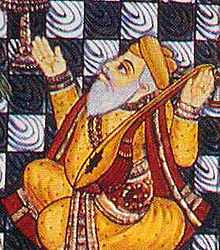Sikh music

See also Kirtan
| Sikhism |
|---|
 This article is part of a series on Sikhism |
| Sikh Gurus |
|
| Philosophy |
|
| Practices |
|
| Scripture |
|
| General topics |
|
|
|
Sikh music or Shabad kirtan is Kirtan-style singing of hymns or Shabad from the Guru Granth Sahib, the central text of Sikhism.
It began in the 16th century as the musical expression of mystical poetry conceived by the founder of Sikhism, Guru Nanak. Following him, all the Sikh gurus sang in the then-prevalent classical and folk music styles, accompanied by stringed and percussion instruments. The style was where the text was of prime significance and the music played a supporting, albeit important, role. The Gurus specified the raag in which they sang each hymn in the Sikh sacred scripture, the Guru Granth Sahib. Sixty raags were and sixtyraag variants were named.[citation needed] Several raag variants are unique to the Sikh music tradition.[citation needed]
While Hindustani music underwent significant changes in the setting of Mughal courts, and a separate stream of Carnatic music developed in southern India, Sikh music retained its original form and styles, a unique musical tradition encompassing a variety of melodic forms and a well-developed percussive system.[citation needed]
In the 20th century the classical style was largely replaced by contemporary popular genres often based on Indian film music. Within the remaining classical tradition, the devotional Gurmat Sangeet style was overtaken by the darbaari khayal style.[citation needed] The harmonium took the place of stringed instruments and the tabla replaced the pakhaavaj and jori.
Significant efforts have been under way since the 1970s to revive the rich Sikh music tradition initiated and developed by the Sikh Gurus. Various terms used to refer to this tradition include Shabad keertan parampara, Gurbani sangeet parampara and Gurmat sangeet.
Sikh musicians
Three types of Sikh musicians are rababis, ragis, and dhadhis.
Raga: melodic scales
Ragas have a direct relationship to human moods and the following are the connections between Ragas and feeling:[citation needed]
- Soohi – joy and separation
- Bilaaval – happiness
- Gaund – strangeness, surprise, beauty
- Sri – satisfaction and balance
- Maajh – loss, beautification
- Gauri – seriousness
- Aasa – making effort
- Gujri – satisfaction, softness of heart, sadness
- Devgandhari – no specific feeling but the Raag has a softness
- Bihaagra – beautification
- Sorath – motivation
- Dhanasari – inspiration, motivation
- Jaitsree – softness, satisfaction, sadness
- Todi – this being a flexible Raag it is apt for communicating many feelings
- Bhairaagi – sadness, (The Gurus have, however, used it for the message of *Bhakti)
- Tilang – this is a favourite Raag of Muslims. It denotes feeling of beautification and yearning.
- Raamkali – calmness
- Nat Narayan – happiness
- Maali Gaura – happiness
- Maaru – giving up of cowardice
- Tukhari – beautification
- Kedara – love and beautification
- Bhairav – seriousness, brings stability of mind
- Basant – happiness
- Sarang – sadness
- Malaar – separation
- Jaijawanti – viraag
- Kalyaan – Bhakti Ras
- Vadhans – vairaag, loss (that is why Alahniya is sung in this Raag when someone passes away)
- Parbhati – Bhakti and seriousness
- Kaanra – Bhakti and seriousness
In addition to raag names, there exists an indication in the titles of hymns called ghar. The precise meaning of ghar is not fully understood, although recent research proposes it refers to raag variants.[1]
Gallery
-

The Rebab was played by Bhai Mardana who accompanied Guru Nanak in all of his travels.
-
The Tanpura was used by Guru Gobind Singh to recite Gurbani Kirtan
-

A Sikh playing the Dilruba which was developed by Guru Gobind Singh
-

Guru Arjan Dev's own Rebab
See also
Further reading
Masukhani, Gobind Singh. 1982. Indian Classical Music and Sikh Kirtan. Chopra, R. M., Glory of Sikhism - Chapter on "Music in Sikhism", ISBN 783473471195 .
Notes
- ↑ See Inderjit N Kaur, .
External links
- Shabad Kirtan Gurbani Keertan, Hymns & Ragas
- Sikh Sangeet - High Quality Shabad Kirtan MP3s
- Sikh Music Heritage Institute
- Kirtan Audio & Video Database
- Soulful Gurbani Kirtan Downloads
- Gurmaat Sangeet Kirtan of Gurbani categorized by shabads
